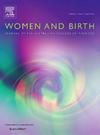The effectiveness of antenatal education on improving labour and birth outcomes – A systematic review and meta-analysis
IF 4.4
2区 医学
Q1 NURSING
引用次数: 0
Abstract
Background
The World Health Organisation has suggested antenatal education be integrated within standard antenatal care. However, evidence for the impact of antenatal education varies. This systematic review and meta-analysis evaluated randomised controlled trial evidence regarding the influence of antenatal education on labour and birth outcomes.
Methods
Electronic databases (CINAHL, PubMed, Embase and Scopus) were searched for randomised controlled trials published between 2011 and 2023. Primary outcomes were mode of birth, epidural analgesia use, and induction of labour. Subgroup analysis by type of education (general education, specific technique, birth plan use) was performed. Three authors reviewed studies and extracted data. Risk of bias was assessed using the Cochrane Risk of Bias 2 tool. Meta-analysis was performed using RevMan.
Results
Seventeen studies (n=7260 participants) were included, most (n=10) had low risk of bias. Antenatal education was associated with decreased rates of planned caesarean sections (Relative Risk (RR) 0.87; 95 % confidence interval (CI), 0.83–0.92, I2=0 %), but not unplanned caesareans (RR 0.99; 95 % CI, 0.88–1.12, I2=0 %),as well as increased vaginal births (RR 1.14; 95 % CI 1.07–1.21, I2=79 %) and increased spontaneous onset of labour (n=10 studies, RR, 1.07; 95 % CI, 1.01–1.14, I2=0 %). Epidural analgesia use (RR, 0.88; 95 % CI, 0.88–1.00, I2=78 %) was not significantly affected. General education and birth plan care interventions were found to be more effective than specific technique care.
Conclusion
Antenatal education programs studied improve some labour and birth outcomes, although with substantial heterogeneity regarding mode of birth and epidural analgesia use findings. General education appeared more effective than specific technique education.
产前教育对改善劳动和分娩结果的有效性——一项系统回顾和荟萃分析。
背景:世界卫生组织建议将产前教育纳入标准的产前保健。然而,关于产前教育影响的证据各不相同。本系统综述和荟萃分析评估了关于产前教育对分娩和分娩结局影响的随机对照试验证据。方法:检索2011年至2023年间发表的随机对照试验的电子数据库(CINAHL、PubMed、Embase和Scopus)。主要结局是分娩方式、硬膜外镇痛的使用和引产。按教育类型(普通教育、特殊技术、计划生育)进行亚组分析。三位作者回顾了研究并提取了数据。使用Cochrane Risk of bias 2工具评估偏倚风险。meta分析采用RevMan软件。结果:纳入17项研究(n=7260名受试者),其中大多数(n=10)偏倚风险较低。产前教育与计划剖宫产率降低相关(相对风险(RR) 0.87;95 %可信区间(CI), 0.83-0.92, I2=0 %),但非计划剖宫产除外(RR 0.99;95 % CI, 0.88-1.12, I2=0 %),以及阴道分娩增加(RR 1.14;95 % CI 1.07-1.21, I2=79 %)和分娩自发性发作增加(n=10项研究,RR, 1.07;95 % ci, 1.01-1.14, i2 =0 %)。硬膜外镇痛使用(RR, 0.88;95 % CI, 0.88-1.00, I2=78 %)无显著影响。一般教育和计划生育护理干预比特殊技术护理更有效。结论:尽管在分娩方式和硬膜外镇痛使用方面存在很大的异质性,但产前教育计划研究改善了一些分娩和分娩结局。通识教育比专门技术教育更有效。
本文章由计算机程序翻译,如有差异,请以英文原文为准。
求助全文
约1分钟内获得全文
求助全文
来源期刊

Women and Birth
NURSING-OBSTETRICS & GYNECOLOGY
CiteScore
7.20
自引率
13.20%
发文量
371
审稿时长
27 days
期刊介绍:
Women and Birth is the official journal of the Australian College of Midwives (ACM). It is a midwifery journal that publishes on all matters that affect women and birth, from pre-conceptual counselling, through pregnancy, birth, and the first six weeks postnatal. All papers accepted will draw from and contribute to the relevant contemporary research, policy and/or theoretical literature. We seek research papers, quality assurances papers (with ethical approval) discussion papers, clinical practice papers, case studies and original literature reviews.
Our women-centred focus is inclusive of the family, fetus and newborn, both well and sick, and covers both healthy and complex pregnancies and births. The journal seeks papers that take a woman-centred focus on maternity services, epidemiology, primary health care, reproductive psycho/physiology, midwifery practice, theory, research, education, management and leadership. We also seek relevant papers on maternal mental health and neonatal well-being, natural and complementary therapies, local, national and international policy, management, politics, economics and societal and cultural issues as they affect childbearing women and their families. Topics may include, where appropriate, neonatal care, child and family health, women’s health, related to pregnancy, birth and the postpartum, including lactation. Interprofessional papers relevant to midwifery are welcome. Articles are double blind peer-reviewed, primarily by experts in the field of the submitted work.
 求助内容:
求助内容: 应助结果提醒方式:
应助结果提醒方式:


